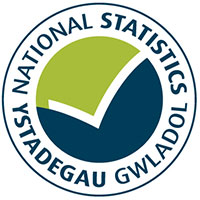Data on average hourly, weekly and annual earnings in the UK down to local authority level for 2022.
This is not the latest release in the series: Annual survey of hours and earnings
The survey provides information about the levels, distribution and make-up of earnings and hours worked for employees in all industries and occupations.
The Annual Survey of Hours and Earnings only covers employees and excludes income earned from self-employment, pensions and other sources.
Impact of the coronavirus (COVID-19) pandemic
The pandemic resulted in a number of complexities that make interpreting earnings data difficult. The Office for National Statistics published a blog explaining this. As a result, estimates for 2020, 2021 and 2022 are subject to more uncertainty than usual.
Main points
Full-time weekly earnings
Median gross weekly earnings for full-time adults working in Wales were £598.1 in April 2022. This was 93.5% of the average for the UK (£640.0). Median gross weekly earnings in Wales were the eighth highest amongst the 12 UK countries and English regions.
Median gross weekly earnings for full-time adults working in Wales increased by 6.1% between 2021 and 2022, compared to a 4.1% increase between 2020 and 2021.
The UK increased by 5.0% over the year. Wales had the fourth highest percentage change amongst the 12 UK countries and English regions.
Residence based earnings
Median full-time weekly earnings for those living in Wales increased by 5.4% (to £603.5) over the year. The level in 2022 was 94.3 % of the UK average.
Gender Pay Gap
The Pay difference (full-time) for gender in Wales is one of the national wellbeing indicators. A national milestone has been set for this national indicator which is to eliminate the pay gap. Please see notes for further information.
The gender pay gap on a median hourly full-time basis (excluding overtime) in April 2022 was 6.1% in Wales and 8.3% in the UK. In Wales the gap widened by 1.7 percentage points and in the UK, it has widened by 0.6 percentage points compared to the previous year.
Over the longer term, the trend for gender pay difference on a median hourly full-time basis (excluding overtime) has seen an overall decrease since the time series began.
The gender pay gap on a median hourly basis (excluding overtime) for all employees in April 2022 was 11.4% in Wales and 14.9% in the UK. In Wales the gap narrowed by 0.2 percentage points and in the UK, it has narrowed by 0.2 percentage points compared to the previous year.
For part time employees women usually earn more than men, resulting in a negative pay gap. The gender pay gap on a median hourly part-time basis (excluding overtime) in April 2022 stood at -3.5% in Wales, widening by 1.7 percentage points compared to the previous year. The gap stood at -2.8% in the UK, narrowing by 0.2 percentage points. The part time pay gap at geographies below the UK level can be volatile.
Notes
Explanation for the difference in the gender pay gap estimate between full-time and all employees
The gender pay gap estimate is calculated as a differential proportion of two median estimates, the middle points of the data, one for female and one for males. The composition of the male and female employee workforces are quite different, with more women working part-time than men (42% compared with 12% respectively; source: Labour Force Survey, Quarter 2 (April to June) 2017, Table EMP04). Because the hourly earnings of part-time employees tend to be less, on average, than the earnings of full-time employees, this means women are more likely to receive lower hourly rates of pay. It's this fact that helps explain why the gender pay gap for all full-time and part-time employees is greater than the gender pay gap for full-time employees only.
Well-being of Future Generations Act (WFG)
The Well-being of Future Generations Act 2015 is about improving the social, economic, environmental and cultural wellbeing of Wales. The Act puts in place seven wellbeing goals for Wales. These are for a more equal, prosperous, resilient, healthier and globally responsible Wales, with cohesive communities and a vibrant culture and thriving Welsh language. Under section (10)(1) of the Act, the Welsh Ministers must (a) publish indicators (“national indicators”) that must be applied for the purpose of measuring progress towards the achievement of the Well-being goals, and (b) lay a copy of the national indicators before Senedd Cymru. The 50 national indicators laid in December 2021 replace the set of 46 national indicators that were laid in March 2016, and this release includes the following national indicator:
- (17) Pay difference for gender, disability and ethnicity
Datasets on StatsWales will be updated following this publication.
Contact
Joe Davies
Email: economic.stats@gov.wales
Rydym yn croesawu gohebiaeth yn Gymraeg / We welcome correspondence in Welsh.

